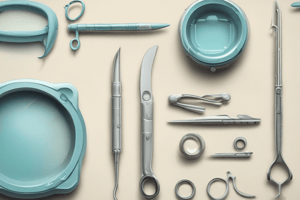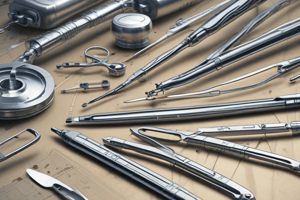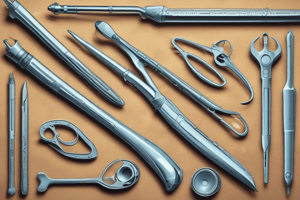Podcast
Questions and Answers
What is the primary purpose of the assembly area in the CSSD?
What is the primary purpose of the assembly area in the CSSD?
- To dispose of contaminated surgical instruments
- To store surgical instruments before usage
- To conduct surgical procedures
- To inspect surgical instruments for intactness and cleanliness (correct)
What environmental standard must the inspection, assembly, and packing room meet?
What environmental standard must the inspection, assembly, and packing room meet?
- ISO 9001: 2015
- ISO 14644-1: 1999 Class 6
- ANSI Z9.5: 2012
- ISO 14644-1: 1999 Class 8 (correct)
Why is it important for the IAP room to be maintained under positive pressure?
Why is it important for the IAP room to be maintained under positive pressure?
- To ensure air flows outward, reducing airborne bacteria risk (correct)
- To allow easy entry of staff into the room
- To maximize the sterilization time of instruments
- To keep the room at a higher temperature
What is a potential risk if lint settles on clean surgical instruments?
What is a potential risk if lint settles on clean surgical instruments?
Which of the following is NOT a requirement for the furniture in the IAP area?
Which of the following is NOT a requirement for the furniture in the IAP area?
How often must environmental cleaning be carried out in the IAP room?
How often must environmental cleaning be carried out in the IAP room?
What is the role of microbiological monitoring in the IAP room?
What is the role of microbiological monitoring in the IAP room?
What is the purpose of placing contact or settle plates during microbiological monitoring?
What is the purpose of placing contact or settle plates during microbiological monitoring?
What is the primary action taken if a container cycle is found to have been used for instruments during washing?
What is the primary action taken if a container cycle is found to have been used for instruments during washing?
Why is it important to check for blockages in the spray arms during the unloading process?
Why is it important to check for blockages in the spray arms during the unloading process?
Excessive wetness in the load after washing may indicate issues related to which of the following?
Excessive wetness in the load after washing may indicate issues related to which of the following?
What must be done if an item is found to be improperly disassembled in the wash area?
What must be done if an item is found to be improperly disassembled in the wash area?
What is the purpose of checking the sharpness of cutting edges in medical devices?
What is the purpose of checking the sharpness of cutting edges in medical devices?
What is the consequence of failing to document non-conformances after unloading?
What is the consequence of failing to document non-conformances after unloading?
Which method is recommended for testing the insulation of devices like diathermy forceps?
Which method is recommended for testing the insulation of devices like diathermy forceps?
What must be ensured regarding the chart record for the cycle during unloading?
What must be ensured regarding the chart record for the cycle during unloading?
If damage due to configuration is suspected, what should the response be?
If damage due to configuration is suspected, what should the response be?
Why should the edges of clamping RMD meet with no overlap?
Why should the edges of clamping RMD meet with no overlap?
What is a key feature of computerized track and trace systems in CSSDs?
What is a key feature of computerized track and trace systems in CSSDs?
In what scenario should an entire load be rejected without further processing?
In what scenario should an entire load be rejected without further processing?
How does the packing list get generated in a CSSD using a computerized system?
How does the packing list get generated in a CSSD using a computerized system?
What is a significant concern when devices are being inspected for functionality?
What is a significant concern when devices are being inspected for functionality?
For CSSDs without a computerized tracking system, what alternative method is used?
For CSSDs without a computerized tracking system, what alternative method is used?
How are devices typically arranged within trays according to procedure requirements?
How are devices typically arranged within trays according to procedure requirements?
What should be done if staining or residue is detected on a load of surgical instruments?
What should be done if staining or residue is detected on a load of surgical instruments?
What is a key factor when inspecting surgical instruments after coming out of the washer-disinfector?
What is a key factor when inspecting surgical instruments after coming out of the washer-disinfector?
Which of the following is NOT part of the quality checks for manually cleaned devices?
Which of the following is NOT part of the quality checks for manually cleaned devices?
Which area of a surgical device is particularly critical to inspect for cleanliness?
Which area of a surgical device is particularly critical to inspect for cleanliness?
What must happen to surgically cleaned items that are not dry before moving to the IAP room?
What must happen to surgically cleaned items that are not dry before moving to the IAP room?
What procedure must be followed if an item is not disassembled correctly for cleaning?
What procedure must be followed if an item is not disassembled correctly for cleaning?
What type of visual inspection should be made before placing surgical devices in a device set?
What type of visual inspection should be made before placing surgical devices in a device set?
What is the primary purpose of comparing testing results to baseline counts of microorganisms?
What is the primary purpose of comparing testing results to baseline counts of microorganisms?
Which process is essential to ensure the effectiveness of the inspection of RMDs?
Which process is essential to ensure the effectiveness of the inspection of RMDs?
What should be done to achieve a baseline contamination level in the IAP room?
What should be done to achieve a baseline contamination level in the IAP room?
Which of the following is NOT a requirement for staff clothing in the IAP?
Which of the following is NOT a requirement for staff clothing in the IAP?
What is the recommended action if a scrub suit becomes visibly soiled or wet?
What is the recommended action if a scrub suit becomes visibly soiled or wet?
What type of headwear is required for personnel in the IAP?
What type of headwear is required for personnel in the IAP?
Which statement accurately describes the shoes worn in the IAP?
Which statement accurately describes the shoes worn in the IAP?
What role do managers have concerning protective clothing in the IAP?
What role do managers have concerning protective clothing in the IAP?
What happens to headgear and beard masks after use in the IAP?
What happens to headgear and beard masks after use in the IAP?
Flashcards
Assembly Area (IAP)
Assembly Area (IAP)
A clean area in the CSSD where surgical instruments are inspected for integrity, cleanliness, and functionality before being used.
Inspection Criteria
Inspection Criteria
Surgical instruments must be inspected for intactness, cleanliness, and functionality.
Decontamination Specialists
Decontamination Specialists
Trained professionals responsible for inspecting and handling surgical instruments in the assembly area.
Positive Pressure
Positive Pressure
Signup and view all the flashcards
ISO 14644-1: 1999 Class 8
ISO 14644-1: 1999 Class 8
Signup and view all the flashcards
Environmental Cleaning Frequency
Environmental Cleaning Frequency
Signup and view all the flashcards
Dedicated Cleaning Room
Dedicated Cleaning Room
Signup and view all the flashcards
Microbiological Monitoring
Microbiological Monitoring
Signup and view all the flashcards
Contact/Settle Plates
Contact/Settle Plates
Signup and view all the flashcards
IAP Room Contamination Baseline
IAP Room Contamination Baseline
Signup and view all the flashcards
IAP Dress Code Requirements
IAP Dress Code Requirements
Signup and view all the flashcards
Scrub Suit
Scrub Suit
Signup and view all the flashcards
Surgical Hat/Hood
Surgical Hat/Hood
Signup and view all the flashcards
Dedicated Shoes
Dedicated Shoes
Signup and view all the flashcards
Washer-Disinfector to Sterilizer
Washer-Disinfector to Sterilizer
Signup and view all the flashcards
Automated Unloading
Automated Unloading
Signup and view all the flashcards
Manual Unloading
Manual Unloading
Signup and view all the flashcards
Quality Checks
Quality Checks
Signup and view all the flashcards
Incorrect Cycle
Incorrect Cycle
Signup and view all the flashcards
Blocked Spray Arms
Blocked Spray Arms
Signup and view all the flashcards
Soil/Stains
Soil/Stains
Signup and view all the flashcards
Excessive Wetness
Excessive Wetness
Signup and view all the flashcards
Damage from Configuration Issues
Damage from Configuration Issues
Signup and view all the flashcards
Incorrect Disassembly
Incorrect Disassembly
Signup and view all the flashcards
Documentation
Documentation
Signup and view all the flashcards
Spray Arm Rotation Issues
Spray Arm Rotation Issues
Signup and view all the flashcards
Operating Cycle Selection
Operating Cycle Selection
Signup and view all the flashcards
Visual Load Inspection
Visual Load Inspection
Signup and view all the flashcards
Uncleaned/Undried Items
Uncleaned/Undried Items
Signup and view all the flashcards
Manually Cleaned Device Acceptance
Manually Cleaned Device Acceptance
Signup and view all the flashcards
Soil and Staining
Soil and Staining
Signup and view all the flashcards
Excessive Wetness
Excessive Wetness
Signup and view all the flashcards
Device Damage
Device Damage
Signup and view all the flashcards
Incomplete Disassembly
Incomplete Disassembly
Signup and view all the flashcards
Documentation Requirements
Documentation Requirements
Signup and view all the flashcards
Inspection and Function Testing
Inspection and Function Testing
Signup and view all the flashcards
Magnification for Inspection
Magnification for Inspection
Signup and view all the flashcards
Device Areas to Inspect
Device Areas to Inspect
Signup and view all the flashcards
Functional Device Checks
Functional Device Checks
Signup and view all the flashcards
Damaged Device Reporting
Damaged Device Reporting
Signup and view all the flashcards
Device Set Completeness
Device Set Completeness
Signup and view all the flashcards
Function Check on Devices
Function Check on Devices
Signup and view all the flashcards
Device Sharpness
Device Sharpness
Signup and view all the flashcards
Insulation Integrity
Insulation Integrity
Signup and view all the flashcards
Diathermy Pinpoint Tester
Diathermy Pinpoint Tester
Signup and view all the flashcards
Free Movement of Parts
Free Movement of Parts
Signup and view all the flashcards
Clamping RMD Edges
Clamping RMD Edges
Signup and view all the flashcards
Screw Tightness
Screw Tightness
Signup and view all the flashcards
Track and Trace Systems
Track and Trace Systems
Signup and view all the flashcards
Barcode Readers (IAP)
Barcode Readers (IAP)
Signup and view all the flashcards
Packing List Generation
Packing List Generation
Signup and view all the flashcards
Unique Barcode Label
Unique Barcode Label
Signup and view all the flashcards
Manual Systems
Manual Systems
Signup and view all the flashcards
Tray Assembly Arrangement
Tray Assembly Arrangement
Signup and view all the flashcards
Study Notes
Assembly Area Inspection
- Assembly area is a clean CSSD area for inspecting surgical instruments before use.
- Instruments are inspected for intactness, cleanliness, and functionality.
- Trained decontamination specialists and technicians carry out inspections adhering to manufacturer guidelines.
- Goal is to optimize sterilization by minimizing contamination risk.
Environmental Requirements
- Ventilation meets ISO 14644-1: 1999 Class 8 or equivalent standards.
- Room maintained under positive pressure to prevent airborne bacteria introduction.
- Temperature maintained at 20–23°C and relative humidity 30–60%.
- Environmental cleaning follows hospital approved policies and procedures.
- Furniture is smooth, non-porous, and easy to clean to prevent lint buildup.
- Daily cleaning prevents contamination from lint.
- Dedicated cleaning room within the IAP area used for cleaning.
Microbiological Monitoring
- Continuous monitoring done to detect contamination issues.
- Contact or settle plates placed in pre-planned locations for monitoring.
- Results compared to baseline contamination levels determined by a microbiologist or contracted specialist.
- Contamination level testing done during unoccupied periods to establish baselines.
Staff Dress Code Requirements
- Staff move between clean and dirty areas via a dedicated clothing-change and hand-wash area.
- Protective clothing worn to prevent contamination of instruments and environment.
- Specialists wear freshly laundered scrub suits, head/hair covers, and designated shoes.
- Dedicated shoes are not used for areas outside the IAP.
- Make-up and jewelry (except wedding bands) are not worn in this area.
Washer-Disinfector (WD) to Sterilizer
- Clean, disinfected instruments and accessories unloaded from the WD.
- Automated or manual unloading with heat-resistant gloves if necessary.
- Quality checks for correct cycle, blocked spray arms, soil or stains, wetness, and damage.
- Documentation of any non-conformances or rejected loads reported to the line manager.
- Checking assembled devices, cleaning, stains, damage, excess wetness.
Manually Cleaned Device Acceptance
- Quality checks for visible soil, stains, and excessive wetness.
- Improper handling or immersion results in rejection.
- Documentation of cleanliness issues.
Inspection and Function Testing
- Each device unloaded from the washer inspected for damage, cleanliness, breakage, stiffness, or corrosion.
- Device sets checked before being placed for device functionality, tightness of joints.
- Device inspection reported to line manager.
Assembly and Checking
- Assembled devices inspected and function tested.
- Computerized track and trace systems log devices.
- Handheld barcode readers.
- Unique barcode labels for each tray and process.
- Tray assembly checklist and manual lables used during assembly.
- Items arranged from left-to-right based on procedure use.
- Follows manufacturer guidelines.
Studying That Suits You
Use AI to generate personalized quizzes and flashcards to suit your learning preferences.




